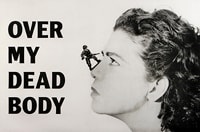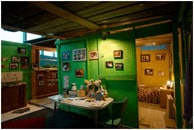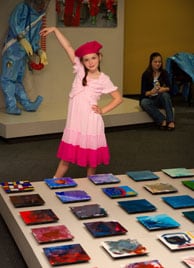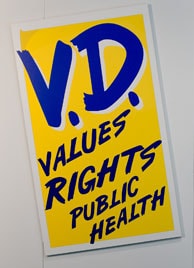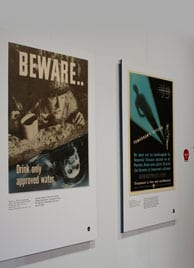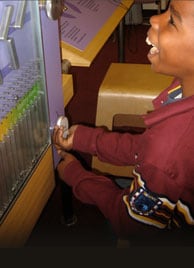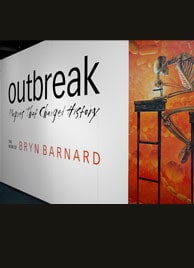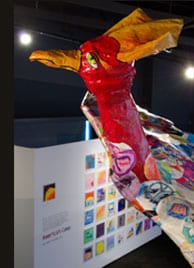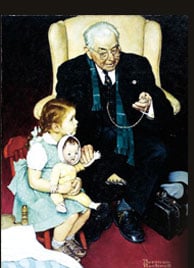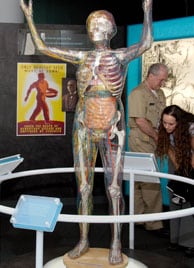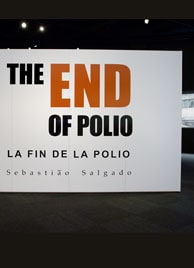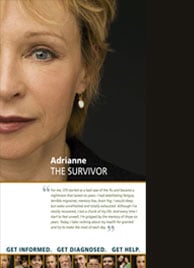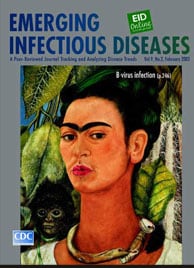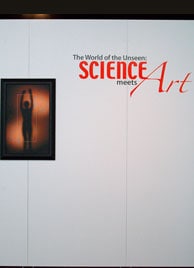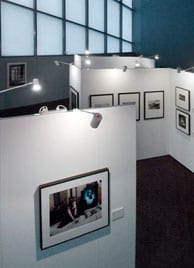Past Exhibits

June 17 – October 25, 2024
In many ways, artists are first responders—to repurpose a term often used in public health and emergency response. Soon after shutdowns began in March 2020, artists took to their studios, desks and Zoom to bear witness and to process the global COVID-19 experience. Stand & Witness: Art in the Time of COVID-19 brings together an international group of artists, poets, authors, and performers to help us understand this collective journey. As the COVID-19 experience continues to ripple through our memories, this exhibition serves as a witness of those times.

May 6 – July 26, 2024
Impacting the health of millions of Americans, asthma is a lifelong disease that causes wheezing, breathlessness, chest tightness, and coughing. In the 1980s and 1990s, improved surveillance showed that asthma prevalence was higher than expected across the nation, prompting a robust federal response.

September 11, 2023 – April 23, 2024
More than 20 years after 9/11, thousands continue to be diagnosed with physical and mental health conditions as a result of their exposure to dust, smoke, debris, and the traumatic events. Tragically, experts predict that these adverse health effects will continue for many decades to come.

Oct 16, 2023 – May 24, 2024
In Ghosts of Segregation, photographer Rich Frishman explores the lingering presence of segregation, slavery and institutional racism hidden in everyday American architecture.

January 9 – September 23, 2023
Since its founding on July 1, 1946, CDC has been at the forefront of public health—the scope of its activities and accomplishments branching across the U.S. and the world. To mark this 75th anniversary, the David J. Sencer CDC Museum staff combed our rich collections and archives to identify rarely seen objects, documents, and media that provide a glimpse into the breadth and depth of CDC’s history.

November 25, 2022 – August 25, 2023
This exhibition spotlights arts and culture partners who worked with CDC and the CDC Foundation in 2022 to help bolster demand for COVID-19 vaccines by building trust and confidence in their communities.

May 2, 2022 – December 2, 2022
This exhibition traces the global impact of influenza viruses since the 1918 pandemic. Influenza viruses are biologically and historically unique. Small changes in their genes occur frequently. Abrupt major changes are less common but can have devastating impact.

June 21, 2022 – November 10, 2022
Typhoidland is an exhibition about the past, present, and future of typhoid control. Organized by researchers from University of Oxford and the David J. Sencer CDC Museum, this international exhibition takes visitors on a journey through 200 years of thinking and managing infectious disease.

May 2 – June 3, 2022
CDC’s Climate and Health Program celebrates 10 years of supporting state, tribal, local, and territorial public health agencies as they prepare for the continuing health impacts of a changing climate.

September 21, 2019 – May 1, 2020
Changing Winds: Public Health and Indian Country is an opportunity to celebrate the contributions of American Indians and Alaska Natives to public health. Aligning good health and wellness with the traditional ways of knowing is at the forefront of culture, language, and practices across American Indian and Alaska Native communities—both rural and urban.

May 20, 2019 – August 30, 2019
The World Unseen: Intersections of Art and Science gathers the work of ten international artists who draw upon microbiology, biotechnology, anatomy, and texts in their investigations of microbes and cells, DNA, history of disease and science, the body, and beauty.

October 29, 2018 – April 26, 2019
This exhibition focuses on humanitarian design solutions in the modern world, examining how design is addressing social, health, economic and environmental challenges faced by communities through the United States. The exhibition is organized around six themes that embody current approaches designers are taking to resolve complex issues

July 9 – October 5, 2018
An immersive museum experience, The Refugee Journey to Wellbeing provides insight into refugee health and the resettlement process. The exhibit introduces visitors to the programs and processes supporting refugee health along the journey from displacement to resettlement in the United States. Its installation at the David J. Sencer CDC Museum is the first public showing of this hands-on exhibit, created in 2016 by CDC’s Division of Global Migration and Quarantine, and the Emergency Response and Recovery Branch, Division of Global Health Protection, in partnership with the American Society of Tropical Medicine and Hygiene.

June 19, 2017 – May 25, 2018
Ebola: People + Public Health + Political Will is an investigation of the historic 2014-16 Ebola Fever Virus epidemic in West Africa, the United States, and around the world. As the crisis unfolded in Guinea, Liberia, and Sierra Leone in 2014, it evolved into both a health and humanitarian crisis. When it became clear that Ebola could potentially spread exponentially, threatening global health security, there was a coordinated, massive response.

Then & Now: Reinventing Quarantine for Globalization celebrates the 50th anniversary of CDC’s Quarantine Program. In 1967, CDC acquired 55 quarantine stations and 500 staff from the US Department of Health, Education, and Welfare. This exhibit is organized by the David J. Sencer CDC Museum and the Division of Global Migration and Quarantine.
November 15, 2016 – May 26, 2017

For the past 30 years, Jim Gathany has been documenting CDC’s scientific achievements, its significant events, its facilities, and its history. A Lens on CDC celebrates Gathany’s long career, the artistry of both his scientific and documentary work, and his incredible contributions to CDC.
July 5 – October 25, 2016

Photographer James Mollison’s breathtaking photography series, Where Children Sleep, captures deeply personal portraits of children from around the world, alongside images of where they sleep each night. The photographs are arresting in the shocking disparity they portray. The viewer is also reminded of the vulnerability of all children, and their need for safe, stable and nurturing environments. So much of these children’s experiences, their daily lives, and their most quiet moments before drifting into sleep are shaped by their circumstances and by conditions beyond their control. The environments in which they are born, live, learn, work, play, worship, age, and sleep affect a wide range of health functioning and quality of life outcomes and risks that affect their entire lives.
January 25 – June 17, 2016
Drawing from across cultures and across scholarly disciplines, the Places & Spaces: Mapping Science exhibition demonstrates the power of maps to address vital questions about the contours and content of human knowledge. Created by leading experts in the natural, physical, and social sciences, visual arts, and the humanities, the maps in Places & Spaces allow us to better grasp the abstract contexts, relationships, and dynamism of science, technology, and innovation. Individually and as a whole, the maps of Places & Spaces allow data to tell stories which both the scientist and the layperson can understand and appreciate.
July 13 – December 30, 2015

For decades, refugee health has been a focus of CDC’s work. Public health, including basic health services and broader surveillance and epidemiological activities, intersects with all stages of the refugee experience. CDC protects the public’s health by promoting and improving the health of refugees, immigrants, and migrants who are coming to the United States, and applies public health and epidemiological science to reduce the health impact of diseases and emergencies on populations and to strengthen the recovery of health systems in these settings.
January 26-June 19, 2015

A flip-flop discarded in Thailand finds its way to Hawaii, and a bottle cast off from a tsunami in Japan becomes Alaska’s beach litter. In a culture dependent upon the modern convenience of plastic, throwaway products of consumption are affecting oceans and shrinking our world as we all become connected through our trash.
A unique art and science exhibition, Gyre: The Plastic Ocean, brings the problem into perspective. Organized by the Anchorage Museum in Alaska, the exhibition explores the complex relationship between humans and the ocean in a contemporary culture of consumption.
September 27, 2014 – January 2, 2015

Government has been a factor in the production, regulation, research, innovation, and economics of our food supply. It has also attempted, with varying success, to change the eating habits of Americans. From the farm to the dinner table, explore the records of the National Archives that trace the Government’s effect on what Americans eat.
Follow the story of the Government’s role in our complex relationship with food from farm to factory and kitchen to table.
May 14 – September 9, 2014

In 2006, the David J. Sencer CDC Museum presented A Journal for Our Times: Emerging Infectious Diseases®. This popular exhibition highlighted the cover art of the journal, beginning with its inception in 1995. The second installment coincides with the Oxford University Press publication of Art in Science: Selections from Emerging Infectious Diseases®.
February 28 – July 15, 2014

Witness features a selection of photographs by Atlanta-based photographer Billy Howard taken on assignment over the past 15 years while working with CDC; the CDC Foundation; CARE; and The Carter Center.
Photographs by Karen Kasmauski
This exhibition features a selection of photographs from IMPACT: Dispatches from the Front Lines of Global Health. A frequent collaborator with National Geographic, Karen Kasmauski is a photographer specializing in global health issues. In the late 1990s and early 2000s, she traveled around the world with CDC staff to document people and places representative of the complexity of public health challenges facing us in the 21st century. Her photographs dramatically capture topics such as children’s health, empowerment of women, safe water, vaccines, education, nutrition, healthy aging, HIV/AIDS, political upheaval, and the impact of climate change.
September 28, 2013 – April 25, 2014

This exhibition examines some historic challenges of the past 120 years in achieving health equity for all in the U.S. We know that “race and place” are as important as personal choices in achieving our full potential. People with low-incomes, minorities, and other socially disadvantaged populations face significant inequities in opportunity for optimal health. This can lead to inequities in health, along the lines of race, ethnicity, and place.
June 17 – September 10, 2013

CANCER: Survivors in Focus—a three-part photography exhibition—offers a glimpse into the lives of people living with, through, and beyond a cancer diagnosis. An estimated 28 million people worldwide are living within five years of a cancer diagnosis.
February 4 – May 24, 2013

Close to 1 billion people live in informal settlements, and that population is projected to swell to 2 billion people by 2030. This accelerated urban expansion will take place primarily in developing and emerging economies in an increasingly climate-challenged world.
June 11 – September 5, 2012
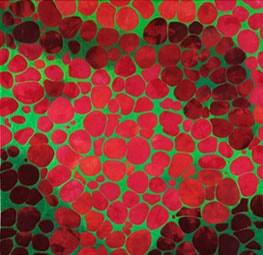
Art Meets Science, organized by the Studio Art Quilt Association, features thirty-five textiles by international artists—all masters in transforming quilt making into art making. Collectively, the textiles draw upon scientific theories or phenomena in new and unexpected ways. They illustrate, with strikingly visual impact, a gamut of scientific ideas, from the harmonies of randomness to the dynamics produced by scientific imagery. Many of the quilts are inspired by the “world unseen”—microscopic reflections of viruses, bacteria, and other cellular forms. David W. Fraser, M.D., the exhibition juror and a textile expert, is also an epidemiologist who was one of the leaders of CDC’s Legionnaires’ disease investigation in 1976-77.
January 30 through May 25, 2012

Earl Dotter is an award-winning photojournalist with a lifelong commitment to documenting American workers. Beginning in the Appalachian coalfields in the 1970s and continuing today, he has put a human face on those who labor in dangerous and unhealthy conditions over a wide range of occupations across the United States. He follows in the tradition of such great American documentary photographers as Jacob Riis, Lewis Hine, Dorothea Lange, and W. Eugene Smith.
The Quiet Sickness is drawn from Dotter’s large archive of black and white photographs documenting workers in the mining, fishing, agriculture, textile, health care, and construction industries, among others. While demonstrating improvements in workplace safety over the past 40 years, Dotter’s photographs also suggest that many workers continue to work in environments that are not safe. Collectively, they make the case for protecting the health of all working people, as well as speak to the dignity and self-respect of the individual worker in America.
January 31– May 20, 2011

Malaria: Blood, Sweat, and Tears was conceived and produced by Malaria Consortium and photographer/curator Adam Nadel. The exhibit uses a variety of media including photographs, stamps, illustration, and 3-dimensional objects, such as mosquito nets, to discuss the history, science, and global impact of malaria. The exhibition, with the support of Vestergaard Frandsen and in cooperation with the Roll Back Malaria Partnership, opened at the United Nations’ main gallery in spring 2010.
Malaria will kill at least 700,000 children this year. In 2009, a minimum of 250,000,000 people contracted the disease, and almost half of the world’s population was at risk. Malaria does more than just kill people; its devastating economic toll has destroyed untold dreams of a better life.
June 6 – September 9, 2011
Off the Beaten Path presents the work of 28 contemporary artists from 24 countries, including Yoko Ono (Japan), Louise Bourgeois (France), Wangechi Mutu (Kenya), Mona Hatoum (Palestine), and Hank Willis Thomas (USA), whose work addresses the issues of violence against women and girls around the world and their basic human rights to a safe and secure life. The project combines cutting-edge art with important social messaging and storytelling to help create awareness, inspiration, and address systems for positive social change and action. Randy Jayne Rosenberg, executive director of the nonprofit group Art Works for Change, is the exhibit’s curator.
September 24, 2011 – January 13, 2012

This exhibit showcases the work of six artists who interpret the act of hand washing in innovative and unexpected ways. Recent H1N1 prevention campaigns have highlighted the importance of hand washing as one of the most effective ways to stay well.
September 25, 2010 – January 14, 2011

On assignment for the CDC Foundation, photojournalist David Snyder has traveled to Kenya, Brazil, Peru, Haiti, India and several cities in the U.S. to report on CDC programs in action. This exhibition features more than 75 photographs and notes from the field. Through his travels, Snyder has captured the unique stories of individuals whose lives have been impacted by the work of CDC and the CDC Foundation. From “Mama Sprinkles,” who distributes micronutrient packets to families in Kenya’s Nyanza Province, to a CDC scientist who devotes his life to preventing violence, Snyder’s images and field notes tell the story of how people, working with common dedication and cause, can improve the health of communities everywhere.
The ASSIGNMENT: CDC photo exhibition is in honor of a generous bequest from the Estate of Frances M. Shillinglaw. The CDC Foundation is an independent, nonprofit organization that helps CDC do more, faster, by forging partnerships between CDC and others to fight threats to health and safety.
June 16 – Sept 3, 2010
Our Home – Nuestra Casa was a testimony to the lives of people affected by tuberculosis (TB), their surroundings, and their messages of reality and hope. The house was filled with individual stories, photographs, and personal items – all contributed by persons affected by TB from the U.S.-Mexico border and the rest of the country. The exhibit reflected the social and political commitment to recognize and put in perspective the TB problem; to increase political will to improve disease prevention and control; and to reduce the stigma and discrimination experienced by persons affected by TB.
Project Concern International and the Alliance of Border Collaboratives, with collaboration from the Mexico National Tuberculosis Program, and financing from USAID–Mexico, took on the commitment to guide Our Home – Nuestra Casa and make this project a reality. The exhibit was sponsored in Atlanta by the David J. Sencer CDC Museum, Office of the Associated Director for Communication, and the Division of Tuberculosis Elimination, National Center for HIV/AIDS, Viral Hepatitis, STD and TB Prevention.
June 16 – September 3, 2010
In this immersive exhibition, museum visitors had the opportunity to roleplay various medical professionals and solve up to three infectious disease mysteries. Participants met interactive patients, analyzed lab tests and learned about the transmission and prevention of infectious diseases. Visitors could choose to solve the mysteries or interact with the exhibit components randomly. Either way, they would understand what causes infectious diseases, how infectious diseases spread, what the public can do to help stop the spread of infectious diseases, and why there are so many emerging and re–emerging infectious diseases.
This exhibit was made possible by a Science Education partnership Award (SEPA) award from the National Center for Research Resources, a component of the National Institutes of Health.
April 29 – May 28, 2010
In an effort to raise awareness about autism, the David J. Sencer CDC Museum presented an art exhibit by young people with autism and related disorders. The young artists created colorful acrylic and resin floor tiles under the supervision of David E. Petersen, Coordinator of the Artists-In-Residence program at Marcus Autism Center. Displayed as a collaborative work, the project was a joint effort of the Marcus School and Early Intervention program, the SPECTRUM Autism Support Group, and the Georgia Chapter of the Autism Society of America.
In recent years, the quest to understand the causes and the nature of autism has increased along with an increase in the numbers of children being identified and diagnosed. Communities have come together in inspiring ways to try to meet the growing needs of families affected by autism. With this exhibit, we celebrate the growing talents, and abilities of children and adults with autism. This work served as testimony to the talents of a group of remarkable community members and brings us into their world through the universal language of art.
February 15 – May 28, 2010
VD: Values, Rights, Public Health chronicled the social and cultural history of venereal diseases (now known as sexually transmitted diseases) in the United States beginning in the 20th century. Through compelling posters, photographs, documents, and relevant historic objects, this exhibit examined the response of public health agencies, medical researchers, the military, non-profit organizations, and communities to what was once considered one of America’s most urgent challenges—particularly prior to the development and widespread use of antibiotics in the second half of the 20th century.
The exhibit demonstrated how language and graphics used by public health and civic leaders strongly reflect the history of the times and reveals how rhetoric underscores community values. Questions about individual rights, stigma, and sexuality are contrasted with issues of societal values, health, and safety. VD: Values, Rights, Public Health illuminated this perennial struggle.
VD: Values, Rights, Public Health is organized by the Global Health Odyssey Museum with the Division of STD Prevention, National Center for HIV/AIDS, Viral Hepatitis, STD and TB Prevention, Centers for Disease Control and Prevention.
September 28, 2009 – January 29, 2010
An Iconography of Contagion: An exhibition of 20th–Century Health Posters featured more than 20 health posters spanning the 1920s to the 1990s, from North America, Europe, Asia, and Africa, and covered infectious diseases such as malaria, tuberculosis, AIDS, gonorrhea, and syphilis. The posters showed the interplay between public understanding of disease and social values, reflecting the fears and concerns of the time, as well as the state of medical knowledge. And they showed how beautiful and entertaining images and designs were used to educate the public on matters of life and death.
This exhibition was sponsored by the Cultural Programs of the National Academy of Sciences. Additional support was provided by the Presidents′ Circle Communications Initiative of the National Academies.
In Atlanta, the exhibition was sponsored by the David J. Sencer CDC Museum, National Center for Health Marketing, Coordinating Center for Health Information and Service, and the Coordinating Center for Infectious Diseases.
June 15 – September 11, 2009
Consequential Matters was an investigation by four Atlanta-based artists of the consequences of urbanization, technology, consumption, indulgence and globalization.
Peter Essick: High-Tech Trash
For a January 2008 National Geographic article about the disposal of scrap electronics, Atlanta-based photojournalist Peter Essick traveled to Africa, Asia, Europe, and the United States. The global trade in “e-waste”—computers, cell-phones, and hard drives, to name a few—has developed exponentially over the past 20 years with resulting environmental and social concerns. This documentary essay bore witness to workers in developing countries who exposed themselves to health risks as they pulled apart monitors or circuit boards to extract copper, gold, silver or lead. Essick also chronicled more environmentally-responsible recycling programs in Europe, and questioned some of our efforts here in the United States.
Mark Wentzel: XLounge x 3
XLounge x 3 was a series of cleverly-adapted Eames Lounge Chairs and Ottomans responding to the apparent consequences of the over-consumption of goods and materials of recent years. Designed in 1956 by the legendary American designers Charles and Ray Eames with mass production in mind, this iconic furniture has come to typify a particular standard for stylish and enduring design products. Artist Mark Wentzel invoked a more universal application in XLounge, alluding to topics of global obesity and consumption, and the potential cooperation among artists, designers, scientists and manufacturers to address such issues.
Carl DiSalvo and Jonathan Lukens: Smog is Democratic
Smog is Democratic explored particulate matter through the medium of visualization. As we inhabit and wear away at the city, we produce dust and debris, and as plants attempt to reproduce, they release pollen. These and other processes create particulate matter, a residue of life. An investigation of particulate matter touches multiple concerns: pollution, the relationship between urban living and hygiene, the tension between scientific and artistic representations of information, and the desire to produce measurement techniques that gauge the threat of the unseen. This installation was interpretive and expressive, with the goal of considering how the sources and measurements of particulate matter might be rendered in order to generate reflection, discussion, and debate.
Consequential Matters was sponsored by the Global Health Odyssey Museum, National Center for Health Marketing, Coordinating Center for Health Information and Service,and the Office of Sustainability in honor of the Go Green, Get Healthy Initiative.
February 26-May 29, 2009
Your Genes, Your Choices targeted upper elementary school students and their parents and was designed to help visitors look at genes from a biological, global, historical, and medical perspective. The interactive stations allowed visitors to explore the concept of genetic variation, the relationship between skin color and solar radiation, the role of genes in causing disease, and the relationship between lifestyle choices and genes in impacting a person’s overall health.
Your Genes, Your Choices was developed and organized by the Hall of Health, Children’s Hospital & Research Center at Oakland. Funding was provided by a Science Education Partnership Award from the National Center for Research Resources, a component of the National Institutes of Health, U.S. Department of Health and Human Services.
In Atlanta, the exhibition was sponsored by the David J. Sencer CDC Museum, National Center for Health Marketing, Coordinating Center for Health Information and Service.
February 17–May 29, 2009

Of the world’s 6.5 billion people, 90 percent have little or no access to most of the products and services many of us take for granted. In fact, nearly half do not have reliable access to food, clean water, healthcare, education, affordable transportation, or shelter. The exhibition Design for the Other 90% featured more than 30 projects that reflect a growing movement among designers, engineers, and social entrepreneurs to create low-cost solutions for everyday problems. Through local and global partnerships, individuals and organizations found unique ways to address the basic challenges of survival and progress faced by the world’s poor.
Design for the Other 90% showcased designs that used conventional and unorthodox methods, new and traditional materials, and ancient and innovative technologies to solve myriad problems—from cleaner–burning sugarcane charcoal to a solar–rechargeable battery for a hearing aid, from a portable water–purification straw to a low–cost laptop. By understanding the available resources and tools as well as the lives and needs of their potential users, these designers created simple, pragmatic objects and ingenious, adaptive systems that could help transform lives and communities.
Design for the Other 90% showcased designs that use conventional and unorthodox methods, new and traditional materials, and ancient and innovative technologies to solve myriad problems—from cleaner–burning sugarcane charcoal to a solar–rechargeable battery for a hearing aid, from a portable water–purification straw to a low–cost laptop. By understanding the available resources and tools as well as the lives and needs of their potential users, these designers create simple, pragmatic objects and ingenious, adaptive systems that can help transform lives and communities.
Design for the Other 90% was organized by Smithsonian Cooper–Hewitt, National Design Museum. The exhibition was made possible by the Lemelson Foundation. Additional support was provided by public funds from the New York State Council on the Arts, a State agency, the Esme Usdan Exhibition Endowment Fund, and the Ehrenkranz Fund.
The exhibition was sponsored, in Atlanta, by the David J. Sencer CDC Museum, National Center for Health Marketing, Coordinating Center for Health Information and Service, the National Center for Environmental Health/Agency for Toxic Substances and Disease Registry, and the Coordinating Office for Global Health.
The CDC Foundation acknowledges the generous gift of Vestergaard Frandsen, Inc., in support of the David J. Sencer CDC Museum and the Design for the Other 90% exhibition in Atlanta.
September 27, 2008–January 30, 2009
Diseases don’t affect just one person’s life —sometimes they change the world. Outbreak: Plagues that Changed History/The Work of Bryn Barnard featured the illustrations and texts of Washington state-based artist and writer Bryn Barnard. The original pieces were taken from his 2005 book for middle school children, which vividly portray the history of public health. From influenza to smallpox, from tuberculosis to yellow fever, the symptoms and paths of the world’s deadliest diseases were examined; along with how the epidemics they spawned changed the course of human history in surprisingly powerful and unexpected ways. Barnard posed questions such as, “Did the Black Death create Europe’s middle class?” and “Did cholera make modern cities?” to create a compelling narrative about infectious disease, medicine, and public health.
Outbreak: Plagues that Changed History was sponsored by the David J. Sencer CDC Museum, National Center for Health Marketing, Coordinating Center for Health Information and Service.
June 16–September 12, 2008
The Complexity of Emergencies: Responding Through Art examined the visual art projects of three organizations working with children affected by emergencies, both in the United States and abroad. The exhibition highlighted the work of The ArtReach Foundation with teachers and children in Bosnia, America′s Camp with children impacted by the September 11 terrorism attack, and The Community Initiatives Foundation with children displaced by Hurricane Katrina.
The impact of a natural or technological disaster, terrorist attack, or other public health emergency can be long-lasting, and the resulting trauma can reverberate even with those not directly affected by the disaster. Children and their families may need special care and assistance in coping. Expression through art has proven to be both a communicative and healing tool, as well as an innovative public health strategy.
Organized by the David J. Sencer CDC Museum, The Complexity of Emergencies: Responding through Art was sponsored by the National Center for Health Marketing, Coordinating Center for Health Information and Service, the National Center for Environmental Health/Agency for Toxic Substances and Disease Registry, and the Coordinating Center for Terrorism Preparedness and Emergency Response.
March 10 – June 4, 2008
Organized by the Norman Rockwell Museum, Picturing Health: Norman Rockwell and the Art of Illustration featured rare, original paintings by Norman Rockwell that inspired Americans to view themselves and their physicians with optimism, and presented the notion that health is affected as much by our emotional lives as by our physical well–being. The outstanding original Rockwell paintings explored the doctor/patient relationship and the importance of physical fitness and health and healing across the generations. They were accompanied by original works exploring similar themes of health and well-being by today’s most prominent visual artists,whose bold graphic statements offer a compelling counterpoint to Rockwell’s painterly narratives.
The exhibit is presented in Atlanta by Global Health Odyssey, National Center for Health Marketing, Coordinating Center for Health Information and Service.
The CDC Foundation acknowledges the generous gift of Pfizer, Inc. in support of the Global Health Odyssey and Picturing Health in Atlanta.
Picturing Health: Norman Rockwell and the Art of Illustration was organized by the Norman Rockwell Museum in Stockbridge, Massachusetts and is being sponsored by Pfizer, Inc.
April 30 – August 10, 2007
Created by the U.S. Holocaust Memorial Museum, Deadly Medicine: Creating the Master Race explored Nazism′s roots in interpretations of biology and genetics, and examined the role played by German physicians, scientists, public health officials, academic experts, and others in the Nazi racial eugenics program that culminated in the Holocaust. The exhibition features artifacts, photographs, video testimonies and film footage.
The exhibition was co–sponsored by the National Center for Health Marketing, Coordinating Center for Health Information and Service. The CDC Foundation acknowledges the generous gift of the Morris Family Foundation, Inc., in support of the Global Health Odyssey and the Deadly Medicine exhibition in Atlanta. Public programs and special events that accompanied the exhibition were co–sponsored by the William Breman Jewish Heritage Museum and supported by a generous contribution from the Marcus Foundation.
August 27, 2007–February 22, 2008
This photography exhibit by world–acclaimed Brazilian photojournalist Sebastião Salgado documented the global effort to eradicate the crippling disease poliomyelitis. Salgado initiated the project in Somalia in early 2001, and by the end of the year he witnessed mass vaccination campaigns against polio in Sudan, India, the Democratic Republic of Congo, and Pakistan. He documented vaccine production in France and specialized lab analysis at CDC, which tracks the last strains of wild poliovirus in the world.
CDC is one of the spearheading partners in the Global Polio Eradication Initiative, along with the World Health Organization (WHO),Rotary International, and the United Nations Children’s Fund (UNICEF).
The exhibition was co-sponsored by the Global Health Odyssey, National Center for Health Marketing, Coordinating Center for Health Information and Service, and Global Immunization Division , National Center for Immunization and Respiratory Diseases, Coordinating Center for Infectious Diseases.The CDC Foundation acknowledges the generous gift of Mr. Robert A.Yellowlees, CDC Foundation Board Member, in support of the Global Health Odyssey and The End of Polio exhibition in Atlanta.
December 3, 2007 – January 4, 2008
The Faces of Chronic Fatigue Syndrome featured huge, full–color portraits (shot by celebrity and fashion photographer George Lange) of eight CFS patients and two CFS experts and included quotes from each about their experiences with this disease. Together, the 10 banners and their first–person accounts told a compelling story about CFS and how it affects lives. The exhibition also included important information about symptoms and diagnosis so people who suspect they have the illness, but haven’t yet been diagnosed, could find the information and help they needed. The Faces of Chronic Fatigue Syndrome was part of the national public awareness campaign sponsored by the CDC and the CFIDS Association of America.
June 26 – September 27 , 2006
Emerging Infectious Diseases® pioneered peer-reviewed journal publishing at CDC. Since 1995, the journal has been breaking new ground—one of the first to go online ahead of print and link cover art with science content.
The journal raises global awareness of new and reemerging infectious diseases and microbial threats, addressing the needs of the most affected: the young, the old, the underprivileged, and those weakened by other illnesses.
Now a hallmark of the journal, cover art emphasizes interdisciplinary content and global reach. Complementing the science, art draws attention to intersections between people, animals, and the environment, at the root of disease emergence, prevention, and control.
Celebrating the accomplishments of this remarkable journal, this exhibit showcased a complete set of covers and selected enlargements. They demonstrated how art humanizes and enhances science by illustrating ideas, revealing truth, stimulating the intellect, and firing the emotions.
Sponsored by: National Center for Health marketing, National Center for Infectious Diseases.
April 24 -June 10, 2006
The idea of revealing the invisible is as compelling a concept to scientists as it is to artists. In an effort to analyze the world we inhabit, scientists gather pictures of cells, viruses, bacteria and even our DNA. These captured images are frequently of uncommon beauty. They make us ponder the wonder of the world in which we live, raising as many questions as answers.
Artists are equally drawn to the world of the unseen for source material, providing springboards from which they interpret advances in current science and what it means to live in the 21st century. In The World of the Unseen: Science Meets Art, artists Richard Gray, Perry Kirk and Eva Kwong made comments about the humanistic and scientific implications of knowing and seeing what we normally cannot see by visually drawing from what is sub-visible.
January 23 – April 14, 2006
Raising the Bar: New Horizons in Disability Sport highlighted the extraordinary achievements of the international para-athletic community. Ten award-winning photographers captured the grace and athleticism of these elite athletes who compete in a wide variety of events from shot put to downhill slalom, cycling to equestrian events, swimming and wheelchair tennis to sitting volleyball and sailing.

